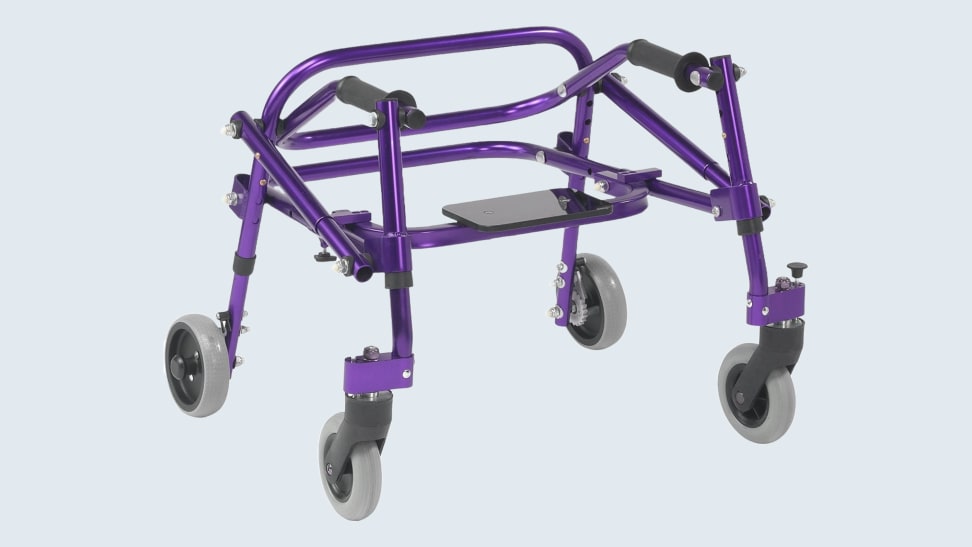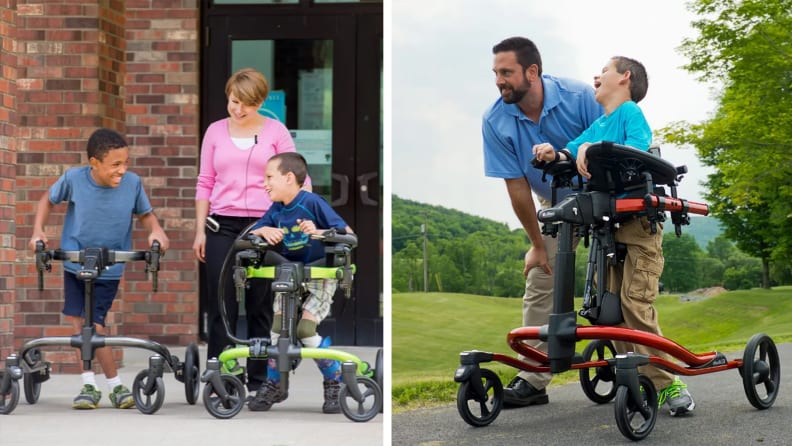 Credit:
Inspired By Drive / Reviewed
Credit:
Inspired By Drive / Reviewed
Products are chosen independently by our editors. Purchases made through our links may earn us a commission.
A gait trainer is medical equipment that supports individuals with mobility challenges so they can stand upright and take steps. Mostly composed of a sturdy material like metal, gait trainers feature a base and wheels. These supports allow someone with a physical disability to effectively balance with enough freedom to reciprocally move their legs.
“Gait trainers hold significant benefits for individuals coping with mobility issues. For those experiencing movement limitations, gait trainers provide critical stability,” says Calum Fraser, CEO & owner of Advantage Physiotherapy. “Gait trainers significantly minimize the risk of falls and injuries, allowing users to explore their mobility safely. This safety aspect also extends to caregivers, reducing their physical strain and potential for injury.”
This article aims to answer the question "What is gait training." We'll explore its advantages, how gait trainers differ from walkers, and feature some sample gait trainers reviewers love. While we can't possibly explain everything gait training has to offer, this introduction should help you feel better acquainted with the subject.
What is gait training?

Gait training is a type of physical therapy that helps patients overcome struggles in muscle strength, balance, posture, weight bearing, and the cyclical motion of walking. In its simplest forms, gait training might involve walking slowly on a treadmill or around traffic cones, but it becomes more involved for those with complex, long-term conditions.
In these cases, a device called a gait trainer provides individuals with cerebral palsy, spinal cord injury, and other motor disorders an opportunity for weakened muscles to bear weight and gain strength. Gait trainers offer a unique way to stay active, move, stretch, and see a different view of the world than the user might be used to.
And, of course, increasing one’s ability to move helps them better interact with everything around them. “Impeded mobility can lead to social isolation. In this regard, gait trainers provide emotional relief by encouraging physical activity, boosting confidence, and enabling social interactions,” explains Fraser.
So what is gait training, then? In its simplest definition, gait training is a physical routine focused on weight bearing. However, when leveraged properly, it can have massive psychological benefits too.
Are there disadvantages of gait exercises?
Gait training has proven to be especially helpful in reducing the mobility limitations of cerebral palsy and other muscular or neurological disorders. However, just like any form of exertion, there are risks one takes if exercises become too strenuous.
If the patient works too hard, they may experience side effects such as mental stress, fatigue, and soreness in muscles and joints. Monitor these symptoms and work with a physical therapist to create the best gait training plan that works for you.
What’s the difference between a gait trainer and a walker?
While gait trainers and walkers share a vaguely similar form factor, they serve different needs. It may be best to think of a gait trainer as a more involved version of a walker, designed to accommodate a greater loss of mobility.
Gait trainers often feature harnesses and add extra supports for those who are unable to bear weight fully. A walker can technically become a gait trainer if these supports are added as accessories. Walking with a walker requires putting full weight on your feet.
Popular gait trainers worth considering
There’s a huge variety of gait trainers available, so it’s important to find the one that feels most comfortable for the user. Some are a simple frame with wheels and are for individuals with mild mobility impairments. Other gait trainers may be custom-made, with a variety of add-ons for someone who needs more support. Keep in mind that each add-on typically increases the price one might pay.
Below you’ll find six gait trainers shoppers love that are made to suit a wide range of needs.
1. MyWay + Gait Trainer

A MyWay + Gait Trainer is ideal for individuals with less trunk control. It comes with a wide, padded harness, shoulder straps, and a variety of optional add-ons such as a headrest, handles, and multiple foot and leg positioning supports.
The metal frame surrounds the back of the user so they can get close to a table for schoolwork, games, crafts, or possibly to kick a ball. Brakes on each wheel improve the trainer’s safety and keep the individual stable when they want to remain sedentary for long periods of time.
2. KidWalk Gait Mobility System

A KidWalk Gait Mobility System is another great gait trainer for someone with less head or trunk control. The hip lateral supports, harness, and add-on head array keep the user upright and comfortable. The larger wheels make this gait trainer a stable option. Other add-ons include an anti-rollback device, ankle prompts, and a variety of color options.
3. Rifton Pacer

The Rifton Pacer is a popular gait trainer that comes in several sizes ranging from small to extra-large. The Pacer also has a variety of optional add-ons such as thigh supports, hip supports, chest supports, a communication tray, and armrests, making it easy to customize.
An attendant guidance bar allows caregivers to help guide the direction of the Pacer, making the user feel safe when moving around and experimenting with taking steps. The Pacer can be fitted so its metal frame is either around the back of the individual or around the front.
4. The Nimbo Posterio Walker

The Nimbo Posterio Walker is good for children or adults with mild cerebral palsy who need support to assist them with steps. The walker is simple to assemble. Reviews are positive, saying the item is durable, lightweight, and easy to collapse just by pressing two buttons. The Nimbo is available in a variety of sizes—from extra small to large—and can be adjusted up to 4 inches for growth and comfort.
5. Klip Gait Trainer

The Klip Gait Trainer has a flip-up seat for someone who needs additional support or to occasionally rest. The Klip is also sold in a variety of sizes, ranging from extra small to large. Optional accessories include lateral hip supports, forearm platforms, a sling seat, and other accouterments. Most reviews of the Klip Gait Trainer are positive, saying it’s quick to put together and collapses easily to take on the road.
6. Pivot Gait Trainer

This Pivot Gait Trainer is available in small, medium, and large sizes, and it’s adjustable in 1-inch increments. Its four wheels rotate around so the Pivot can move in any direction, but it also has locks on its wheels to keep the user safe. A trunk support, hip positioner, thigh prompts, ankle prompts, and a guide bar are also available for an additional fee.


